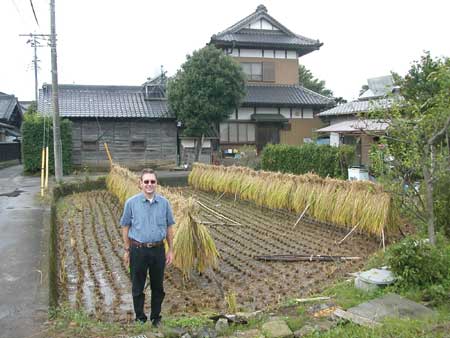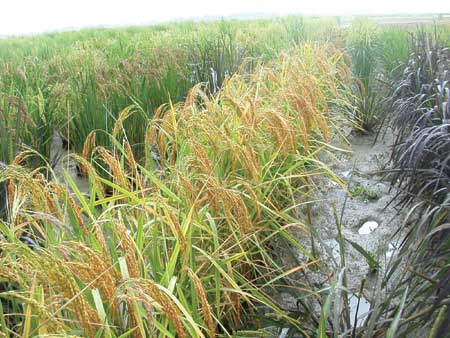Unlocking the Genetic Codes of Rice and Maize
Research paves the way for worldwide studies
2003
Arizona Agricultural Experiment Station Research Report
![]()
Written by
Susan McGinley
Modern pioneers dive into the deepest oceans, catapult into space, find
new species or create new ways to heal disease. They explore cyberspace,
stumble upon ruins of ancient civilizations, or maybe they delve into
the immense world of DNA strands, conducting fantastic voyages along the
chromosomes and mapping one gene after another.
This is the world of scientists at the University of Arizona and several
collaborating institutions who are developing tools that will unlock the
genetic codes of rice and maize and serve as models for biological, agricultural
and environmental research worldwide.
Rod Wing and Vicki Chandler, both from the plant sciences department in the College of Agriculture and Life Sciences, and Cari Soderlund, of the UA Institute for Biomedical Science and Biotechnology (IBSB) and the plant sciences department, are principal investigators on separate genome projects. Their work is funded through the National Science Foundation (NSF) as part of the National Plant GenomeInitiative (see sidebar).
Wing, professor of plant sciences and director of the Arizona Genomics Institute, was awarded a $9.7 million grant to develop a complete map of the genus Oryza, which contains all species of wild and domesticated rice.
“Rice feeds half the world’s population and that’s the group that will double in population in the next 50 years,” Wing says. “We need to know all we can about it. We want to decode the rice genome to understand the regulatory mechanisms for disease resistance and drought control. Once we understand how this works we can design more drought-tolerant, disease-resistant crops and grow them in a more environmentally friendly way on less land. We can use fewer pesticides and less water.”
Wing and his colleagues from the UA, Purdue and New York’s Cold Spring Harbor Laboratory are developing a closed-model system to unravel and understand the evolution, physiology and biochemistry of the rice genus.
“It’s a project I’ve been dreaming about for three to four years,” Wing says. Called the Oryza Map Alignment Project, or OMAP, Wing says this will be the first project in any system where a complete genus—every single species—will be characterized at the genome level. Wing and his team will align the genomes of the wild species to the sequenced rice genome.

Rod Wing, director of the Arizona Genomics Institute, stands in front of harvested rice at a small family farm in Tsukuba, Japan.
“This has never, ever been done in animals or plants,” Wing says. Over millions of years the 13 species of rice have evolved and adapted to different environments all over the world—swamp, shade, salt water and other conditions. Including the wild species of rice and aligning them with the genomes of domesticated rice species on the OMAP will enable researchers to find new genes for improving cultivated rice.
This resource will be a platform for researchers around the world to explore the diversity and evolution of rice genes and will serve as a model to establish similar systems in both plants and animals. Rice will be sequenced by the end of 2004.
“We’ll be able to learn about all sorts of phenomena,” Wing says, “the origin of species, where things are rapidly evolving, and where they are evolving more slowly. The questions are limitless. We’re going into brand new territory now.”
Chandler, Regent’s professor and co-director of the IBSB, is developing low-cost, public sector microarray resources for analyzing gene expression in maize, the most economically important crop in the United States.
She has received a $3.7 million NSF grant to continue this work, along with UA plant scientist David Galbraith and researchers at The Institute for Genomic Research (TIGR) in Maryland, the University of Wisconsin and the University of Minnesota.
Microarrays, also known as gene chips, consist of thousands of DNA samples arrayed in rows of orderly dots bonded to a specially prepared glass microscopic slide. The first generation array that the Chandler group is designing will contain 50,000 genes out of an estimated 60,000 in the corn genome.
“We are developing the microarray chips, supplying them to researchers and also making available a large amount of baseline data that can be used to generate hypotheses that others can use to design experiments,” Chandler says. “The idea is to show what the technology can do and educate people in how to best use it.”
The entire corn genome will eventually be available on two glass slides, enabling researchers to monitor genes turning on and off under different conditions and learn more about how they work. All of the data will be quickly available within a public database, so that investigators at institutions that do not have the resources to perform the experiments themselves will have access to the data, according to Chandler.
Adding to the strength of the maize genome project is Cari Soderlund’s research on the technical aspects of gene sequencing. Approximately 80 percent of the 2,400 megabase maize genome is repetitive DNA that generally does not contain genes. There is an intitiative by the NSF Plant Genome program to sequence the gene-rich regions of maize. Soderlund’s project is contributing by generating sequences that will link the fragments of gene sequences across the repetitive regions.
“We will develop a web-based genome browser in order to verify our
results and elucidate the structure of maize,” Soderlund says. “This
will also allow scientists around the world to view their genes of interest.”
Funded by a $925,712 grant from the same NSF genome initiative, this study
will expedite maize genome sequencing and gene discovery, leading to more
gene targets for crop improvement.
The increased emphasis on the plant genome in these and other pioneering projects will radically change fundamental plant science research and its application to agriculture, forestry, energy, and the environment, as well as to the production of pharmaceuticals and other plant-based industrial chemicals and materials.

Examples of rice field trials at the USDA Dale Bumpers Rice Research Center in Stuttgart, Arkansas.
NATIONAL PLANT GENOME INITIATIVE
The National Plant Genome Initiative (NPGI) involves several federal agencies, including the National Science Foundation, the National Institutes of Health and the United States Department of Agriculture.
The NPGI was established in 1998 with the understanding that the major challenges facing mankind in the 21st century are the need for increased food and fiber production, a cleaner environment, and renewable chemical and energy resources. Plant-based technologies can play a major role in meeting each of these challenges.
National Plant Genome Initiative funding has helped make the UA Department of Plant Sciences one of the strongest in the country. The department has consistently pulled in $5 to 15 million annually in grants for the past five years.
CONTACT:
Vicki Chandler
(520) 626-8725
chandler@ag.arizona.edu
Rod Wing
(520) 626-9595
rwing@genome.arizona.edu
Cari Soderlund
(520) 626-9600
cari@genome.arizona.edu
Return to the Title Page
Return to the Table of Contacts
The University of Arizona is an Equal Opportunity/Affirmative
Action Employer. Any products, services, or organizations that are mentioned,
shown, or indirectly implied in this publication do not imply endorsement
by the University of Arizona.
Published January 2004
Return to College publication list